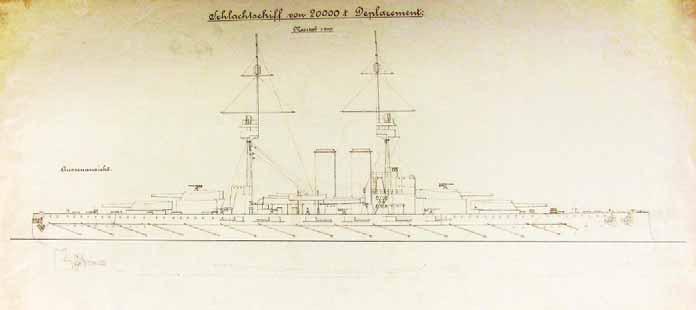mm.151 The final result of this was that the reinforcement of the hull structure resulted in the return to the original 280 mm belt armor.152 The torpedo protection system of the 20,000 ton battleships differed from the system used on the Radetzky class but it was not much more efficient. On the battleships of the Radetzky class the 54 mm thick inner side of the double hull was the torpedo bulkhead and the depth of the system was 1.5-2 meters. On the dreadnoughts there was a Kofferdamm, a vault space between the inner side of the double hull and the 50 mm thick torpedo bulkhead and the depth of the system was 2.4-2.8 meters. Between the torpedo bulkhead and the 15 cm and 7 cm magazines bulkheads there was another Kofferdamm of 0.9-1.2 m closed in by a light 9 mm bulkhead. The specification of 9 June and especially the attached sketch drawing described a different system arrangement: there was a vault space between the inner hull and a light bulkhead and there was another space for reserve coal between the light bulkhead and the torpedo bulkhead. This system was at least 1-1.2 meters deeper than that of Popper. Looking at the plans of the Tegetthoff class, it is obvious that there was the possibility to form a deeper protective system by changing the torpedo bulkhead and the light bulkhead of the magazines without any further serious modifications. This system would have been 3.6-3.8 meters deep at the boiler and machinery rooms and 4-4.5 meters deep at the 30.5 cm magazines. It is still a secret why the Navy accepted Popper’s arrangement while many of their officers and naval architects were fully aware of the flaws of his system. On 11 November 1909, Montecuccoli informed Tirpitz in a letter that the Austro-Hungarian Navy was to build 20,000 ton battleships with four triple turrets. In his letter of 26 November Tirpitz expressed his well-wishes to Montecuccoli for “choosing such an original type of battleship”.153 Later Tirpitz became the most vehement critic of the Austro-Hungarian dreadnoughts. The Final Design The displacement of the Tegetthoff class was 5,500 tons or 38 percent greater than the displacement of the Radetzky class, which was the greatest leap in the history of the Austro-Hungarian Navy. The
greatest part of the increase was the result of the increases to the armament and the armor protection, whereas the speed of the two classes was nearly identical. The weight of the vertical armor was 1,300 tons or 35 percent greater, the thickness of the belt armor was increased by 22 percent (from 230 to 280 mm) while the thickness of the casemate armor was increased by 50 percent (from 120 to 180 mm). The weight of the main battery including gun turrets rose from 1,833 tons to 2,798 tons (53 percent). Even the price of the new battleships was much greater: 60.6 million Kronen per unit against the 39.3 million Kronen per unit price of the Radetzky class. The main battery of the Tegetthoff class consisted of the same 30.5 cm/45 Škoda guns which were used on the Radetzky class, but twelve of them were mounted on the new battleships instead of four. At the time of the design process (1908-1909), the Navy was content with the 30.5 cm caliber and considered it sufficient even with the shorter, 45 caliber length version of this gun after reviewing the problems that Škoda had had with the development of the 50 caliber length version. The 30.5 cm guns of the Tegetthoff class slightly differed from the earlier guns: these guns were designated as K10 and their chambers were 5 cm longer so that they could handle a heavier propellant charge in a longer case. The ammunition hoists of the triple turrets were also larger so that they could handle the longer 5 crh projectiles. These more streamlined projectiles gave the gun somewhat greater range. The Škoda manufactured fifty-two K10 guns in total, four of them being spares. The twelve 30.5 guns were mounted on four triple turrets, two turrets were in the bow and two turrets were in the stern all on the centerline and the two inner turrets were in superimposed position. This turret arrangement gave the ships a heavy six guns end on fire capability and a twelve gun broadside fire capacity. The triple turrets were much heavier than originally designed, they weighed 682-692 tons (superimposed turrets were heavier) without the armored cupolas of the turret rangefinders instead of the 623 tons weight guaranteed by the Škoda. The turrets were all electric operated (train, elevation and ammunition hoists). The four turrets were fed by four 300 KW turbine-driven dynamos. Breeches, loading cars and chain rammers were hand operated. From
— 63 —






























